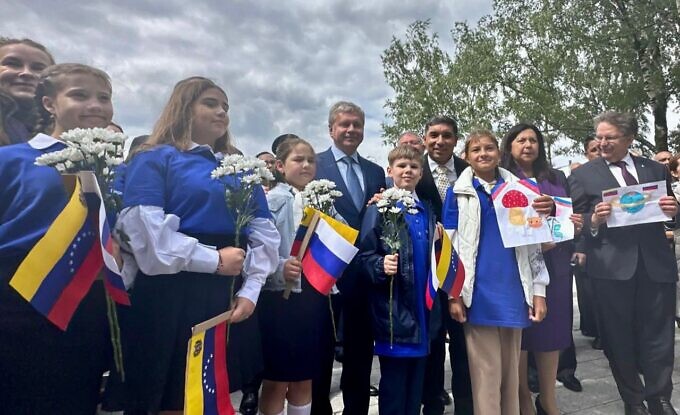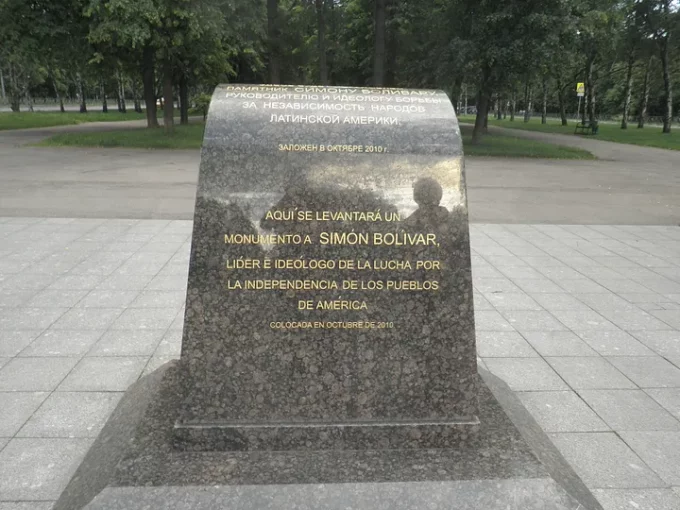
Inauguration ceremony of the statue of Simón Bolívar in Moscow, Russia. Photo: Alexey Filippov/Sputnik.

Orinoco Tribune – News and opinion pieces about Venezuela and beyond
From Venezuela and made by Venezuelan Chavistas

Inauguration ceremony of the statue of Simón Bolívar in Moscow, Russia. Photo: Alexey Filippov/Sputnik.
A true-to-life replica of the statue of Liberator Simón Bolívar, which stands in Bolívar Square in Caracas and was originally inaugurated in 1874 by Antonio Guzman Blanco, has been unveiled in Moscow, Russia. The grand unveiling ceremony took place on Wednesday, July 19, just a few days prior to the 240th anniversary of the birth of this eminent South American revolutionary.
Simón Bolívar, a revered leader, played a momentous role in emancipating the people of Venezuela, Colombia, Bolivia, Ecuador, and Peru from the yoke of the Spanish Crown.
The monument is located at the intersection of Vernadsky Avenue and Universitetski Avenue in Moscow.
The ceremony was attended by Venezuelan Ambassador to Russia Jesús Salazar; Venezuelan Minister of Petroleum Pedro Rafael Tellechea; the mayor of Caracas, Carmen Meléndez; the deputy prime minister of Russia, Alexander Novak; Russian Ambassador to Venezuela Sergey Melik-Bagdasarov; the director of the Latin American Department of the Russian Foreign Ministry, Alexander Schetinin; and the director of the International Department of the Moscow government, Sergey Cheremin.

“The sculpture of our Liberator, unveiled in Moscow, weighs 3,000 kilograms, has a total volume of 4.5 cubic meters, occupancy volume of 39.77 cubic meters, width of 5 meters, and a height of 4.30 meters. This copy of the statue in Bolívar Square of Caracas is the work of Venezuelan sculptor Manuel Suescun,” Caracas Mayor Carmen Mélendez explained.
The mayor further noted that the work was carried out in three phases: modeling, casting, and assembly and installation. “The modeling was done in Mucuchíes, Mérida, with five tons of clay; and then the casting and assembly was also done there,” she said. “Then, with 70% produced by welding, this sculpture and its polishing was completed in Moscow and was placed on its pedestal.”
World Meeting on the Validity of Hugo Chávez’s Bolivarian Thought Begins in Caracas
The monument, skillfully crafted by Venezuelan sculptor Manuel Suescun, required several months of meticulous work before it was delivered to the foundry. As a true connoisseur of Simón Bolívar’s life and history, Suescun shared with Russian media Sputnik that the monument captures “the true face” of the Liberator, achieved through “cutting-edge digital technology.”
Regarding the casting technique employed, foundryman Francisco Hernández explained that the method used—lost wax casting—has been practiced since ancient times. The entire team from Venezuela, responsible for completing and installing the sculpture in Russia, felt completely at home during their stay. “We have received an incredible treatment here, despite not knowing the Russian language—it has been a very warm welcome,” he said.

Russian sculptor Alexandr Gladkikh, who also contributed to the creation of the monument, highlighted the professionalism of his Venezuelan colleagues. “Their bronze casting is of high quality,” he said. “Its thickness is about five millimeters. I would say that we have something to learn from them.”

Architect Adamailyn Gómez, a member of the team, explained that the Simón Bolívar statue installed in Moscow is a “slightly larger” copy of the original located in Caracas. “It is an honor for us to bring our Liberator, such a representative figure for our city and for our country, to Moscow,” she said.
The cornerstone of the monument was installed in 2010 by the then Venezuelan President Hugo Chávez during his official visit to Russia. That ceremony was presided over by the then acting mayor of Moscow, Vladimir Resin.
Translation: Orinoco Tribune
OT/SC/KZ
Support Orinoco Tribune team’s unique, amazing, and unmatched work!
5.5 years providing honest and responsible anti-imperialist information about the Global South!
66 months working for you, 18.5K posts published, 60 original pieces in the last 4 months, 21 YouTube interviews over the last 12 months, and much more to come!
Your donations make a big difference!